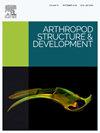Anatomy of the light organ of the glow-worm Arachnocampa flava (Diptera; Keroplatidae)
IF 1.3
3区 农林科学
Q2 ENTOMOLOGY
引用次数: 0
Abstract
In dipteran glow-worms (genus Arachnocampa) bioluminescence is produced by cells of the Malpighian tubules. Light is used to lure prey into sticky webs secreted by the larvae. Larvae can regulate the intensity of the emitted light so neural control of the glow is likely, either acting directly on the light-emitting cells or through regulation of oxygen access to the light organ. Here we describe the innervation, musculature, and tracheal supply in relation to the three-dimensional structure of the light organ, cryptonephridial complex and hindgut using serial section light microscopy and micro computed tomography (μCT). We also use video macrophotography to observe light emission in live larvae. Tracing of trachea in serial sections showed no structures that could actively restrict air supply to the mass of trachea termed the reflector. A bilateral pair of nerves lie alongside the Malpighian tubules and give rise to branches that innervate the hindgut and musculature. A network of muscles surround the light organ. A cryptonephridial complex anterior to the light organ is surrounded by a connective tissue sheath. The fact that the cryptonephridial complex is a plesiomorphic trait in Keroplatidae, the majority of which are not bioluminescent, suggests that the light organ is evolutionarily derived from the complex. We also propose that the cryptonephridial complex has a water conservation function in Arachnocampa because the larvae are potentially water-restricted. The three-dimensional reconstruction of the light organ provides morphological context for ongoing investigations of the biochemistry of light production and the physiological regulation of light output.
黄光蜘蛛(Arachnocampa flava)发光器官的解剖(双翅目;角蛾科)
在双翅目萤火虫(蛛形目属)中,生物发光是由马氏小管细胞产生的。光被用来引诱猎物进入幼虫分泌的粘网。幼虫可以调节发出的光的强度,因此可能是神经控制发光,要么直接作用于发光细胞,要么通过调节氧气进入发光器官。在这里,我们用连续切片光学显微镜和微计算机断层扫描(μCT)描述了神经支配、肌肉组织和气管供应与光器官、隐肾复合体和后肠三维结构的关系。我们还使用视频微距摄影观察活幼虫的发光情况。气管的连续切片示踪显示没有结构,可以主动限制空气供应到气管的质量称为反射器。一对双侧神经位于马氏小管旁边,并产生分支,支配后肠和肌肉组织。肌肉网围绕着光器官。光器官前的隐肾复合体被结缔组织鞘所包围。隐眼复合体是角斑蝶科的一种多形特征,其中大部分不发光,这表明光器官是由该复合体进化而来。我们还提出,隐肾复合体在蛛形目中具有保水功能,因为幼虫可能受到水分限制。光器官的三维重建为正在进行的光产生的生物化学和光输出的生理调节的研究提供了形态学背景。
本文章由计算机程序翻译,如有差异,请以英文原文为准。
求助全文
约1分钟内获得全文
求助全文
来源期刊
CiteScore
3.50
自引率
10.00%
发文量
54
审稿时长
60 days
期刊介绍:
Arthropod Structure & Development is a Journal of Arthropod Structural Biology, Development, and Functional Morphology; it considers manuscripts that deal with micro- and neuroanatomy, development, biomechanics, organogenesis in particular under comparative and evolutionary aspects but not merely taxonomic papers. The aim of the journal is to publish papers in the areas of functional and comparative anatomy and development, with an emphasis on the role of cellular organization in organ function. The journal will also publish papers on organogenisis, embryonic and postembryonic development, and organ or tissue regeneration and repair. Manuscripts dealing with comparative and evolutionary aspects of microanatomy and development are encouraged.

 求助内容:
求助内容: 应助结果提醒方式:
应助结果提醒方式:


